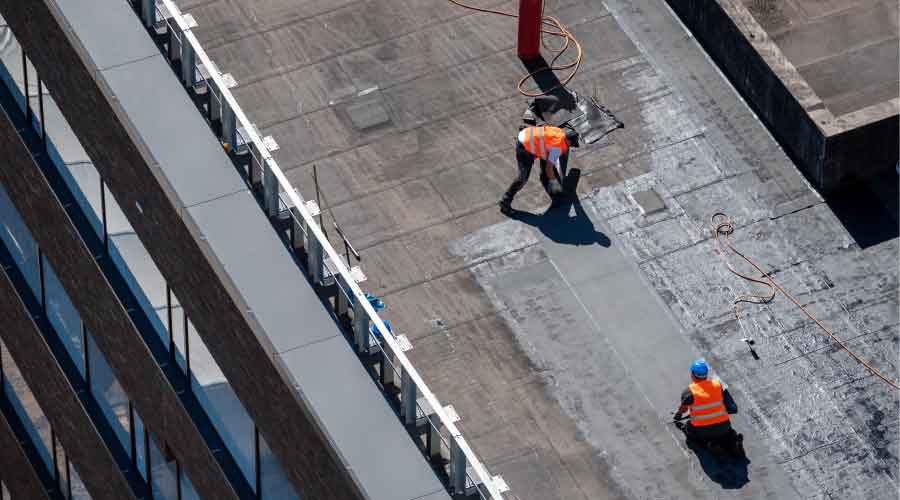Today’s hospitals are not what they used to be. Rooms and hallways are equipped with sensitive, high-efficiency equipment and programming to provide the latest and greatest in care. But if these components get wet, it’s lights out. A small, undetected leak caused by a rainstorm in April could fry the lights in an operating room in the middle of surgery in September and lead to devastating and costly consequences.
Healthcare facility managers must avoid such situations at all costs, and it starts by ensuring facility roofs are in excellent condition and updating them if they are not.
Assess
The first step in gauging roofing asset infrastructure is to assess the facility’s roof according to industry guidelines and best practices. The National Roofing Contractors Association (NRCA), local certified roofing companies and a facility’s insurance provider all have standards to meet, and managers need to be sure hospitals meet all of them. Like inspections from The Joint Commission, standards are in place for good reason, which ultimately comes down to prioritizing patient care.
The next step is to examine the roof based on the highest level of standards. If the roof meets or exceeds these standards, devising a strategy to maintain, preserve and extend the life of the original asset — rather than a run-to-failure plan — will ensure the original asset is acceptable and sustainable. Preserving roofing assets is not only critical to a hospital’s bottom line. It also diverts construction waste from landfills – one of the largest contributors.
Repair or replace?
For roofing assets that do not meet standards and regulations, managers need to examine the workload that would be required to bring them up to acceptable levels. This will vary by location and insurance guidelines. For example, if a roof’s insulation is less than 25 percent wet, it might be able to be restored rather than fully replaced. This situation can lead to significant cost savings and drastically reduce the investment needed in long-term roofing maintenance, allowing other improvements or renovations to move forward.
If a roof has reached the end of its intended life cycle or has severe weather damage following a storm, unfortunately, a manager has no choice but to replace it. This step cannot wait. Hospitals cannot just tell patients to relocate down the street while a bucket collects water leaking from the ceiling.
As with all construction projects in healthcare facilities, the location of asset repair determines what, where and how repairs can take place. Are repairs taking place over a patient room or an operating room? Will the construction generate dust, noise or material odors? Contractors have to be aware of where they are working and understand the level of patient care taking place within the facility.
Redundancy and details
Hospital roofing is unlike other commercial roofing. At healthcare facilities, the most important consideration should be in detailing – focusing on the internal operations of the building to protect the interior conditions. Reducing risk is extremely important, and that only comes with redundancy in the system.
The geographic location of a facility is also important. Managers with hospitals in warmer climates should select white roofs for reflectivity, whereas roofs in colder climates should have more insulation to increase an asset’s R-Value.
Depending on where a facility is located, managers need to consider more durable materials due to potential damage from snow and ice. Redundancies make this possible. For example, to further resist extreme weather conditions, a facility’s flashings could use a termination bar and then a reglet-mounted counterflashing. Insurance assessors and regulating agencies have specific requirements to ensure roofs can withstand extreme weather conditions, which vary by location.
Healthcare facilities managers must be proactive in assessing their roofing assets before extreme weather hits, a leak is discovered or worse. Catching issues earlier will disrupt operations less and save on costs, materials and headaches. Managers need to get out there and take a tour of the facility’s roof. Be critical and thorough, and do not defer maintenance because a small leak will not stay small for long.
Dan Collins is national infrastructure program director with Medxcel. He oversees the national roofing program and replicated its success for the organization’s facades and parking structures.

 Building Disaster Resilience Through Collaboration
Building Disaster Resilience Through Collaboration Amae Health Expands to New York City
Amae Health Expands to New York City Hospital for Special Surgery Opens Two New Facilities in New Jersey
Hospital for Special Surgery Opens Two New Facilities in New Jersey Should We Be Testing Toilet Water in Patient Restrooms?
Should We Be Testing Toilet Water in Patient Restrooms? Healthcare Union Petitions for Increased Staff Safety at HCA Florida Hospitals
Healthcare Union Petitions for Increased Staff Safety at HCA Florida Hospitals